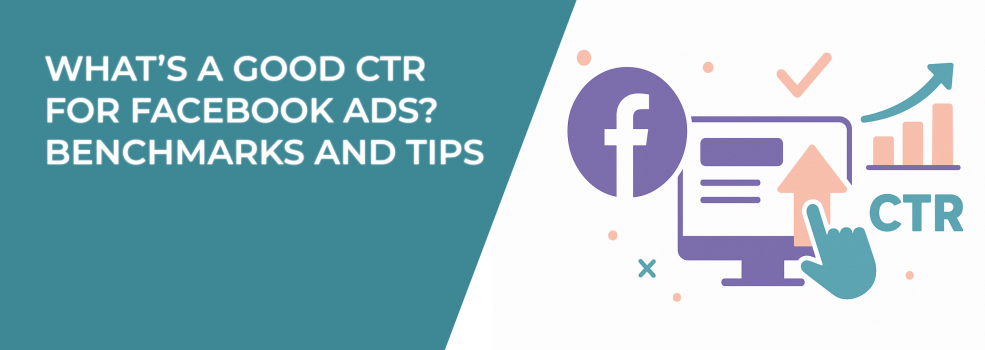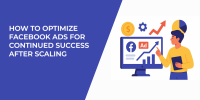How do you know if your Facebook ad is actually working? One number often holds the answer — or at least part of it: click-through rate (CTR). But defining a “good” CTR is more complicated than just hitting a number. What’s considered successful in one campaign might be disappointing in another.
Let’s cut through the noise. Here’s what you should expect in 2025, how to interpret CTR across different formats and industries, and how to improve it.
CTR isn’t just a metric: it’s a message
CTR reflects how compelling your ad is. A strong CTR signals that your audience is paying attention, and they’re interested enough to act. That doesn’t just mean better performance — it often means lower costs, higher engagement, and more conversions down the line.
But there’s nuance. A 0.9% CTR might be weak for a retargeting campaign but completely fine for a cold-audience awareness push. So before chasing high percentages, you need to understand what CTR actually represents for your goals.
Here’s how to dig deeper:
-
Look at the CTR in the context of the campaign’s intent. Is it for awareness, engagement, or sales?
-
Use CTR alongside other metrics like cost per click (CPC), conversion rate, and ROAS to see the full picture.
-
Track CTR over time to spot trends. A declining CTR might signal ad fatigue or audience saturation.
Also, compare CTR across audience segments and funnel stages to uncover what’s really driving performance. High CTR is good, but relevant CTR is better.
What’s the average CTR for Facebook Ads in 2025?
Across most industries, a typical CTR for Facebook ads hovers just under 1%. That’s the baseline. In some sectors — especially those driven by visuals and lifestyle branding — CTR climbs well above that. Retail, beauty, apparel, fitness, and legal all tend to perform higher. Their ads often feature bold visuals, recognizable models, and emotionally resonant offers.
On the other end of the spectrum, industries like finance, insurance, and job training often struggle to break above 0.5%. These categories face tougher competition for attention and usually deal with complex, less visually-driven offers.
So, what’s “good”?
-
Under 0.5% — below average. You may need to revisit your targeting, creative, or value proposition. Try A/B testing new hooks and switching up your imagery.
-
0.9–1.1% — solid. You’re on par with typical performance. Focus on refining messaging or scaling what's already working.
-
1.2–1.6% — strong. Your message is resonating with your audience. Consider investing more budget and expanding your audience segments.
-
2.0% or higher — excellent. This is usually reserved for highly optimized campaigns or warm audiences. Replicate the structure across other campaigns.
Don’t just compare against averages. Compare against your own past performance, audience segment, and campaign goal.
CTR by placement and format
Where your ad shows up and how it’s formatted impacts CTR significantly.
Interactive formats lead the pack. Think polls, quizzes, and gamified content that invites action. These often draw higher engagement, with CTRs over 1.2%. Carousel ads, especially those using video, also perform well due to their dynamic and swipeable nature. Standard video ads come next, followed by static images.
Placement matters, too. Ads in Facebook’s video streams or in-feed placements typically outperform those in Instagram feeds or Stories. The difference? Timing and intent. Feed users scroll with more attention, while Story viewers tend to swipe quickly past content. A well-placed Facebook feed ad might deliver triple the CTR of the same ad on Instagram.
What you can do:
-
Split-test the same creative across multiple placements to find your sweet spot.
-
Customize creative for each placement rather than using a one-size-fits-all approach.
-
Use vertical video for Stories and Reels, but keep copy brief and hooks immediate.
If you’re only testing one format in one placement, you’re leaving performance on the table. Want a deeper look at which ad types work best for different goals? Read The Ultimate Guide to Facebook Ad Formats to learn how to choose the right format for every campaign.
Funnel stage and CTR expectations
You wouldn’t pitch a product to someone who’s never heard of it the same way you would to someone ready to buy. The same principle applies here.
-
Cold audiences – They don’t know you. Expect lower CTRs, maybe around 0.5–0.9%. Your goal here is to educate and attract. Use eye-catching creatives and simple messaging that builds trust and interest.
-
Warm audiences – These users have seen your content or visited your site. CTRs typically jump to 1.2–1.6% if the offer is aligned. Highlight social proof or benefits they may already be aware of.
-
Hot audiences – People who’ve added to cart, signed up, or engaged heavily. You can see CTRs spike above 2% if you match intent with relevance. Offer urgency or exclusive discounts to close the deal.
Segmenting your campaigns by funnel stage helps you set realistic benchmarks — and adjust your expectations.
Pro tip: use Facebook’s Engagement Custom Audiences to segment by video views, page visits, or time on site. Then tailor the creative and CTA accordingly.
If you're still figuring out who to target and how, check out our guide on Facebook Ad Targeting 101 — it breaks down how to reach the right people and set your campaigns up for better engagement from the start.
How to Improve Your Facebook Ads CTR
Improving CTR isn’t about tricks. It’s about clarity, emotion, and alignment.
1. Craft ads that stop the scroll
Use images or videos that demand attention — but don’t overdo it. Think contrast, facial expressions, and uncluttered design. Ads that evoke curiosity, surprise, or familiarity tend to win the scroll battle.
Try this:
-
Use close-up shots of people making eye contact.
-
Add subtle animation to static images to catch the eye.
-
Avoid text-heavy visuals unless absolutely necessary.
If your ad doesn’t grab attention right away, most people will scroll past without a second thought. The goal here is to make them pause — even just for a moment — so they’re curious enough to read more.
2. Write copy that speaks directly
Effective copywriting doesn’t sell features. It taps into pain points, dreams, and outcomes. Lead with value — what do users get when they click? Get specific. Avoid vague claims. The more relevant the message, the higher the CTR.
You can improve your copy by:
-
Asking a compelling question right away.
-
Using numbers and results to anchor expectations.
-
Keeping the message tight — aim for clarity over cleverness.
Think of your ad copy like a friendly chat. Be clear. Be real. And make sure the next step feels natural and worth it.
3. Test formats, not just variants
A single image vs. a carousel can make or break your performance. So can Stories vs. Feed. Test different combinations deliberately. Keep variables controlled to isolate what’s working.
Use a testing framework like this:
-
One audience. One CTA. One headline.
-
Test two to three ad formats side by side.
-
Let it run for at least 72 hours before making decisions.
Testing helps you find out what works, not just what looks good. Small changes can make a big difference in clicks.
4. Warm up your audience
Cold traffic can’t always carry your CTR. Build middle-funnel audiences — video viewers, page engagers, website visitors — and remarket to them. Warm audiences typically deliver 2–3x higher CTRs when targeted correctly.
Build your warm pool by:
-
Running short engagement campaigns with video content.
-
Installing the Meta Pixel on your site to track visits.
-
Using lead magnets or free offers to gather email signups.
People are way more likely to click when they already recognize your name. Warm audiences give you a better shot at a higher CTR, more leads, and more sales.
5. Refresh creatives often
Ad fatigue is real. Even the best-performing ads burn out fast. Watch for declining CTR over time, and have fresh creatives ready to rotate in. Regular refresh cycles help maintain performance — and signal quality to the algorithm.
Signs of fatigue include:
-
Sudden drop in CTR with steady impressions.
-
Rising CPCs without a change in targeting.
-
Poor engagement on the same ad shown repeatedly.
You don’t have to create a brand-new ad from scratch. Just change the image, switch up the headline, or use a new call to action. A small update can wake things back up and get people clicking again.
Measuring what matters
CTR is useful, but it’s not everything. High CTR doesn’t guarantee conversions. Low CTR doesn’t always mean failure. The key is understanding how CTR connects with your larger goals — whether that’s leads, sales, engagement, or reach.
Monitor multiple CTR types when analyzing performance:
-
Link CTR – Clicks to your landing page or offer.
-
Outbound CTR – Clicks that take users off Facebook (especially important for ecom or lead gen).
-
All Clicks CTR – Includes likes, comments, and page views — useful for engagement campaigns.
Make it actionable:
-
Customize your columns in Meta Ads Manager to track each CTR type separately.
-
Compare CTRs across campaign objectives like awareness, traffic, and conversions.
-
Use custom reports to view CTR trends over time and by audience segment.
Track, compare, and adjust based on your campaign objective.
If your ads are getting clicks but not converting, take a look at this step-by-step fix guide to help you identify what’s missing after the click.
So, what’s a good CTR?
There’s no one-size-fits-all number. A good CTR depends on your industry, audience, placement, ad format, and campaign goal.
But here’s a simple rule of thumb. If you’re consistently over 1%, you’re in a healthy zone. If you’re under 0.5%, it’s time to diagnose and optimize. And if you're hitting 2%+? You’re doing something right — now double down and scale it.
The trick isn’t to chase the highest CTR. It’s to make sure your clicks lead somewhere meaningful.

